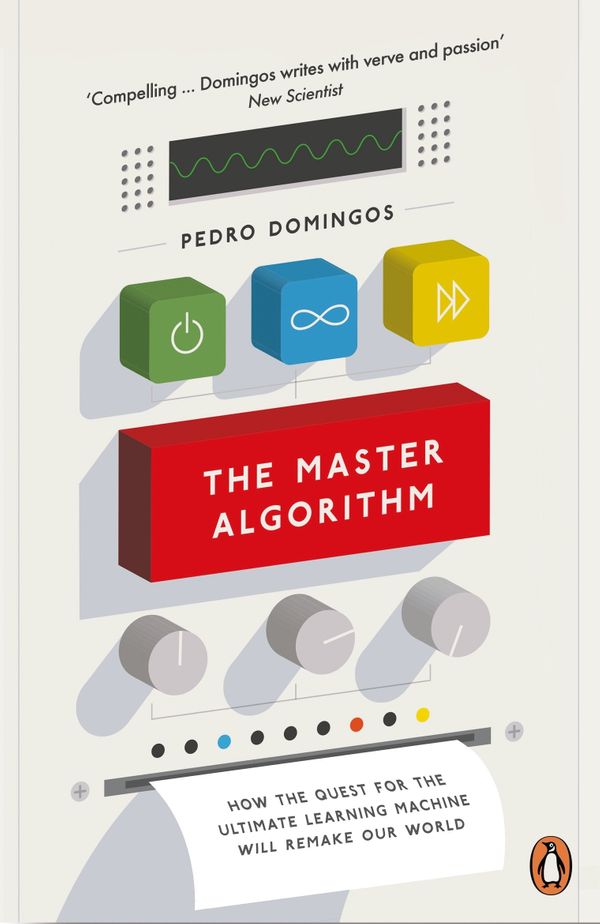By Pedro Domingos (2015)
Pages: 352, Final verdict: Great-read
Harvard Business Review declared Data Scientist the sexiest job of the 21st century, back in 2012. And everywhere you look the words "artificial intelligence", "machine learning" and "algorithms" appear.
Coming from one of the leading brains in the machine learning (ML) realm and professor at the University of Washington, Pedro Domingos demystifies what ML is all about. And to add more flavor to mix, he shares with all of us his recipe for the master algorithm that will eventually become the master learner of our world.
Machine Learning is everywhere
Every time you open your email, check Google Now for updates on your flight or watch a movie recommended by YouTube, machine learning is at work. In fact, nowadays 1/3 of the Amazon.com business come from its recommendations engine (= machine learning). And while the art of making computers "learn" has been around for decades (many of the core algorithms we use today have been invented in the 70's and 80's), the exponential growth in data generation and declining cost of computer power has fueled the dissemination of machine learning outside academia.
In short, ML algorithms are those that are fed samples of data (e.g house prices based on the number of rooms, size, and its location), and turn them into general algorithms to for prediction (e.g how much will your house sell for).
Not aiming at explaining what the science is and how it works (the books does a great job there), the first thing you need to know is that machine learning algorithms can be classified into 2 main categories:
- Supervised Learning: The computer is shown data with both the input and output and learns a general rule of prediction. One example is assessing if a mass shown on an X-ray is cancer or not.
- Unsupervised Learning: No output of the data is given with the objective of finding structure/patterns in the data, like the clusters of articles you can see on Google News
After the stage as been set and the introductions have been made, Pedro Domingos focuses most of the book on what the main schools of ML thought are (all of them capable of designing both types of ML algorithms), and who will be decisive in building the "master algorithm".
"Machine Learning is something new under the sun: a technology that builds itself. - Pedro Domingos
The tribal war in search of the holy grail
If there is a master algorithm to be found, one general learner that can help us anywhere from medicine, finance to autonomous driving, it will surely come from the foundations and practices of the current ML world.
To enlight us of what sets the different schools of ML thought apart, Pedro Domingos defines five "tribes" of machine learning:
-
Symbolists: They view learning as the inverse of deduction, and their main algorithms start by taking the main premises and conclusions and working backward through reverse deduction.
-
Connectionists: Inspired by physics and neuroscience, they reverse engineer the human brain. Currently very fashionable, their favorite algorithm is neural networks (that mimic what the logic behind data transmission in our brain).
-
Evolutionaries: They simulate evolution, natural selection and the principals behind our genome mutations to create algorithms that evolve and can tackle unknown conditions.
-
Bayesians: Understand learning as a form of statistical inference. The method of choice is Bayes theorem and are among the most popular in ML.
-
Analogizers: As the name implies, these scientists are inspired by psychology and believe most learning can be done by drawing comparisons elsewhere in nature.
Much like any fight for supremacy, tribal "wars" also took place in machine learning. And while we learn how (and why) the different have "fought the battle", Pedro takes us back to school to explain what is behind the algorithms. Remember Bayes theorem, Markov Chains, neighborhood search and how neurons work? If you don't, The Master Algorithm will take care of that...
At the end of that day, the book's premise is quite simple. If our lives and the universe are governed by the same 4 forces (gravity, electromagnetism, strong and weak nuclear forces) then we should be able to design a single algorithm that learns from consequences of those laws and generalizes it to become an agnostic learner. Its possibilities would be limitless (the same logic could help us cure cancer and make cars driving themselves). Only time will tell when (and if) this learner will come to life.
The last chapters are where Domingos materializes his bold premise of a master algorithm, showing us its own equation for the general learner (pretty cool stuff!).
Bottom line
There is no escaping. Artificial intelligence, machine learning, robotics and other forms of intelligent computing are here to stay. And whether you're in medicine, business, engineering or pretty much anything else, the more you know about the impending AI tsunami our society faces, the better.
The Master Algorithm will take you beneath the hood of what machine learning is. Not your "Machine learning for dummies" book, you gain more out of it by glazing through a couple of intro articles to the science (see in "Further learning"). And even though it is meant for the general public, I must confess I felt it slightly too technical at times, and perhaps a bit too long.
Curious about AI, statistics, computer technology and the future of our society? Then The Master Algorithm is sure to be a great addition to reading plans this Spring.
Further learning:
- Buy the book online.
- Machine Learning course from Coursera
- Introdctionary (fun!) articles on Machine Learning
- How Google is remaking itself into a Machine Learning first company, a Backchannel article



